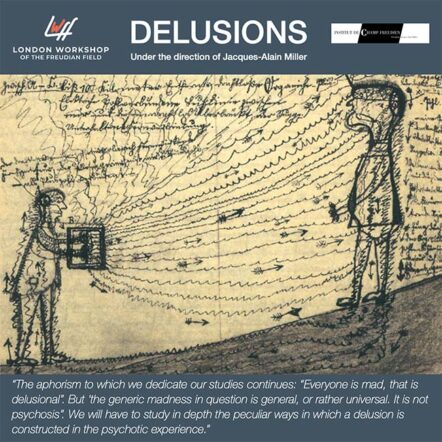The seminar on “Delusions” will be held during the academic period 2022-2023 in the framework of the London Workshop of the Freudian Field, founded by Jacques-Alain Miller on the 13th of July this year. It will form part of the research and studies leading up to the 2024 WAP Congress, whose theme has been announced by J.-A. Miller: “Everyone is mad.”[1]
We can situate this announcement in our era of depathologisation and attempts to replace the clinic with the law. In the face of this, Lacanian analysts respond that: “to be frank, we do not believe in mental health […] mental health does not exist. It is a dream, a fiction”, […] “each of us has a mad streak.”[2] Lacan did not say “Everyone is normal.”
Psychoanalysis teaches us that the law is not capable of dealing with the human being’s peculiar relationship with reality, a relationship that Freud discovered to be precarious, subject to “the pleasure principle in so far as it implies the possibility of the dream [which] presents itself to us as hallucinatory.”[3] The reality principle never fully replaces the pleasure principle and, in the life that he constructs, the parlêtre (speaking being) loves the marks of his dreams and hallucinations.
The aphorism to which we dedicate our studies continues: “Everyone is mad, that is,delusional.”[4] But “the generic madness in question here is general, or rather universal. It is not psychosis.”[5] We will have to study in depth the peculiar ways in which a delusion is constructed in the psychotic experience. We will rely, among other texts, on J.-A. Miller’s 1995 lecture, “The Invention of Delusion,”[6] in which he refers to the “elementaryphenomenon-delusion binomial,” as what responds to the attempt to differentiate elements common to all speaking beings. “Given that everyone’s ego is delusional, a delusion can be considered an accentuation of that which each one carries within him or herself, which it is possible to write as a ‘deliriyo’.”[7]
However, in the clinic of this “each one,” it will be a question of locating, “in the delusional discourse as a whole, the minimal elements, the primary elements on the basis of which the rest was constructed, developed and elaborated.” This approach seeks to locate the elementary phenomenon, that which “functions as a basic axiom, incomprehensible and disturbing for the subject, but which, as an axiom, cannot be questioned. […] a gross, bizarre fact that arises in him” – a thought echo, an involuntary movement, hallucinations and bodily events – “to which he reacts by trying to give an account with delusional explanations and constructions.”
Although elementary phenomenon and delusion are two different moments of the eruption of an illness, both phenomena have to do with the fact that the human being inhabits language, or perhaps, in certain cases, is inhabited by it. Thus, J.-A. Miller sets out three proposals that we can take up in our work:
1) “The elementary phenomenon is to psychosis what the formation of the unconscious is to neurosis. On a reduced scale, it shows the structure of the whole illness.”
In formations of the unconscious, one signifier calls for another signifier and sometimes a slip of the tongue emerges that surprises the subject, alienated by a link between signifiers that does not depend on what he intends to say, but which introduces a new signification. In the elementary phenomenon, on the contrary, it is a question of a signification of signification that on the one hand, is totally incomprehensible and enigmatic to the subject, but on the other, entails the certainty that it involves a sign that concerns him personally, an extremely disturbing fact from which he cannot flee and before which he remains perplexed. The repetition of elementary phenomena constitutes a push to delusion, a time Lacan called a “fecund moment.” There are two times at stake here, in the first the subject is passive and confronted by an unbearable perplexity, and in the second, he actively exercises a work of interpretation and invention.
2) The elementary phenomenon can be approached on the basis of metaphor and metonymy, the two fundamental mechanisms for the production of meaning.In the moment of perplexity, when there is no meaning produced that can satisfy the drive, we are faced with the paradox of an immobile metonymy that does not slide, along with an impotent metaphor. Instead of the relief that thinking can sometimes bring, a state of diffuse and anguished confusion is therefore produced.
3) An operator of perplexity: S(?)s.
Lastly, J.-A. Miller proposes a very simple operator of perplexity in the form of the formula: S(?)s. This is an operator which affirms that in the elementary phenomenon, which causes unbearable perplexity, there is, implicitly or explicitly, a signifier.
We will embark on this seminar following an invitation of Lacan’s transmitted by J.-A. Miller: to be a little more psychotic, a little more perplexed and not eliminate all questions with our previous knowledge.
Setting out from their psychiatric definition, we will study different forms of delusion – each one illustrated with clinical cases.
NOTES
- Closing presentation of the WAP’s Great International Online conversation on the theme “Woman does not exist,” 3rd April 2022.
- Jacques-Alain Miller, “Speaking Through One’s Body” in Hurly-Burly, no. 11 (2014), pp. 131-32.
- Jacques Lacan, The Seminar, Book XVI, From an Other to the other, Lesson12, “The Freud Event” (unpublished).
- Jacques Lacan, “There Are Four Discourses”, Culture/Clinic, no. 1 (2013), p. 3.
- Jacques-Alain Miller, “Everyone is Mad”, Culture/Clinic, no. 1 (2013), p. 39 [from his 2007-2008 Course, “Everyone is Mad”, (11/06/2008).
- Jacques-Alain Miller, “The Invention of Delusion”, available online (later unattributed quotations refer to this text).
- In Spanish, a combination in one word of the words “delusion” and “ego.”


